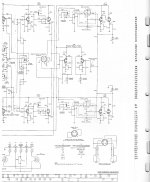I have attached a schematic for a Fisher preamp. It uses a 12DW7 / 7274 in the final stage. The high mu section is the first triode and the low mu is used as a cathode follower.
As I understand it, the gain is developed in the first triode and the cathode follower is close to, but just under, unity.
If my understanding is correct, then that begs the question, why not just use a 12AX7, since the mu of the second stage is not really coming into play?
I'm sure there is a good reason and I'd like to be let in on it.
Thanks
As I understand it, the gain is developed in the first triode and the cathode follower is close to, but just under, unity.
If my understanding is correct, then that begs the question, why not just use a 12AX7, since the mu of the second stage is not really coming into play?
I'm sure there is a good reason and I'd like to be let in on it.
Thanks
Attachments
Last edited:
Source impedance (which is inversely proportional to gm) and current swing capability, especially driving any kind of capacitance. There may be a worse CF tube than a 12AX7, but not many.
The 12DW7 is 1/2 'X7 and 1/2 'U7. The 'U7 section makes for a tolerable cathode follower.
If you are willing to work hard at reworking the layout, installing 'X7s and 'U7s may be feasible.
If you are willing to work hard at reworking the layout, installing 'X7s and 'U7s may be feasible.
That's interesting. I did't know that source impedance is inversely proportional to GM. I'd like to learn more about that. I have a copy of Morgan Jones 3rd ed; I'll do some reading.
If anyone can link me to some good reading on the subject, I'd be grateful.
If anyone can link me to some good reading on the subject, I'd be grateful.
The 12DW7 is 1/2 'X7 and 1/2 'U7. The 'U7 section makes for a tolerable cathode follower.
If you are willing to work hard at reworking the layout, installing 'X7s and 'U7s may be feasible.
No, a 12DW7 is not that hard to come by. It's the understanding I'm after.
Jones explains it pretty thoroughly. Basically, the looking-in impedance is rp/(1+mu) because the plate is at AC ground. If mu >>1, then that reduces to 1/gm.
OK, I get it. I'm re-reading the chapter on the common cathode triode amplifier and it is more clear now. Thanks SY.
- Status
- Not open for further replies.
- Home
- Amplifiers
- Tubes / Valves
- Substituting a 12AX7 for a 12DW7
